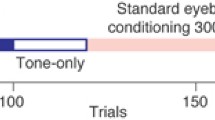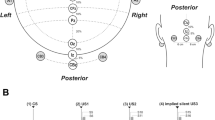Summary
An important aspect of the control of movement is how the nervous system produces adaptive gain modification. To investigate this problem in a simple motor system, we studied lid movement and orbicularis oculis muscle activity in human and rabbit subjects during adaptation of reflex eye blinks. The gain of the reflex could be increased or decreased, depending upon the nature of the adaptive stimulus. Since these gain changes could persist upon removal of the adapting stimulus, adaptation appears to result from a modification of the neural program subserving the blink reflex. The orbicularis oculis electromyogram revealed that the neural modifications producing adaptive gain changes predominantly altered the longer latency components of the reflex, while the short latency components remained unchanged. Moreover, in two other paradigms that modulate the gain of reflexes, habituation and reflex modification, similar changes also occured primarily in the longer latency components of the blink reflex. This result suggests that modification of neurons in longer latency, indirect pathways, may underlie different forms of motor learning.
Similar content being viewed by others
References
Bjork A, Kugelberg E (1953) The electrical activity of the muscles of the eye and eyelids in various positions and during movements. Electroencephalogr Clin Neurophysiol 5: 595–602
Dengler R, Rechl F, Struppler A (1982) Recruitment of single motor units in the human blink reflex. Neurosci Lett 34: 301–305
Evinger C, Manning KA (1987) Cellular investigation of the adaptive gain control of the blink reflex: modulation of orbicularis oculis motoneurons. Neurosci Abstr 13: 174
Evinger C, Shaw MD, Peck CK, Manning KA, Baker R (1984) Blinking and the associated eye movements in humans, guinea pigs, and rabbits. J Neurophysiol 52: 323–339
Fitzgibbon EJ, Goldberg ME, Seagrave MA (1986) Short term saccadic adaptations in the monkey. In: Keller EL, Zee DS (eds) Adaptive processes in visual and oculomotor systems. Pergamon Press, Oxford, pp 329–334
Fuchs AF, Kaneko CRS, Scudder C (1985) Brainstem control of saccadic eye movements. Ann Rev Neurosci 8: 307–337
Gay AJ, Salmon ML, Windsor CE (1967) Hering's law, the levators, and their relationship in disease states. Arch Ophthalmol 77: 158–160
Hiraoka M, Shimamura M (1977) Neural mechanisms of the corneal blinking reflex in cats. Brain Res 125: 265–275
Horak FB, Nashner LM (1986) Central programming of postural movements: adaptations to altered support-surface configurations. J Neurophysiol 55: 1369–1381
Lisberger SG (1984) The latency of pathways containing the site of motor learning in the monkey vestibulo-ocular reflex. Sci 225: 74–76
Lisberger SG, Pavelko TA (1986) Vestibular signals carried by the pathways subserving plasticity of the vestibulo-ocular reflex. J Neurosci 6: 346–354
Lowitzsch K, Luder G (1985) Habituation of the blink reflex: computer assisted quantitative analysis. Electroencephal Clin Neurophysiol 60: 525–531
Manning KA, Evinger C (1986) Different forms of blinks and their two-stage control. Exp Brain Res 64: 579–588
McCollum G, Horak FB, Nashner LM (1985) Parsimony in neural calculations for postural movements. In: Bloedel JR, Dichgans J, Precht W (eds) Cerebellar functions. Springer Berlin, pp 52–66
McCormick DA, Lavond DG, Thompson RF (1982) Concomitant classical conditioning of the rabbit nictitating membrane and eyelid responses: correlations and implications. Physiol Behav 28: 769–775
Miles FA, Kawano K (1986) Short-latency ocular following responses of monkey. III. Plasticity. J Neurophysiol 56: 1381–1396
Nashner LM (1976) Adapting reflexes controlling the human posture. Exp Brain Res 26: 59–72
Rushworth G (1962) Observations on blink reflexes. J Neurol Neurosurg Psychiat 25: 93–108
Sanes JN, Ison JR (1979) Conditioning auditory stimuli and the cutaneous eyeblink reflex in humans: differential effects according to oligosynaptic or polysynaptic central pathways. Electroencephal Clin Neurophysiol 47: 546–555
Sanes JN, Foss JA, Ison JR (1982) Conditions that affect the thresholds of the components of the eyeblink reflex in humans. J Neurol Neurosurg Psychiat 45: 543–549
Schechter RJ (1978) Ptosis with contralateral lid retraction due to excessive innervation of the levator palpebrae superioris. Ann Ophthalmol: 1324–1328
Shahani B (1970) The human blink reflex. J Neurol Neurosurg Psychiat 33: 792–800
Snyder LH, King WM (1986) Vertical VOR adaptation in cat. Neurosci Abstr 12: 253
Sunohara N, Tomi H, Satoyoshi E, Shigekuni T (1985) Glabella tap sign. Is it due to a lack of R2-habituation. J Neurol Sci 70: 257–267
Tamai Y, Iwamoto M, Tsujimoto T (1986) Pathway of the blink reflex in the brainstem of the cat: interneurons between the trigeminal nuclei and the facial nucleus. Brain Res 380: 19–25
Tackmann W, Ettling T, Earth R (1982) Blink reflexes elicited by electrical, acoustic and visual stimuli. I. Normal values and possible anatomical pathways. Eur Neurol 21: 210–216
Van Allen M, Blodi FC (1962) Electromyographic study of the reciprocal innervation in blinking. Neurology 12: 371–377
Zametkin AJ, Stevens JR, Pittman R (1979) Ontogeny of spontaneous blinking and of habituation of the blink reflex. Ann Neurol 5: 453–457
Author information
Authors and Affiliations
Rights and permissions
About this article
Cite this article
Evinger, C., Manning, K.A. A model system for motor learning: adaptive gain control of the blink reflex. Exp Brain Res 70, 527–538 (1988). https://doi.org/10.1007/BF00247600
Received:
Accepted:
Issue Date:
DOI: https://doi.org/10.1007/BF00247600




